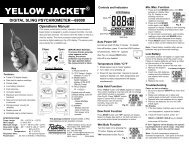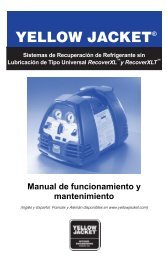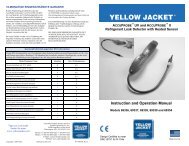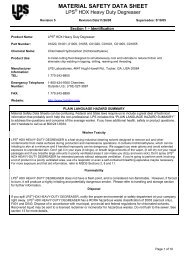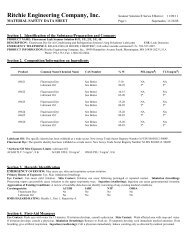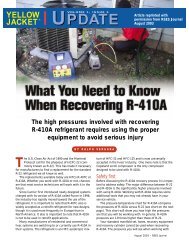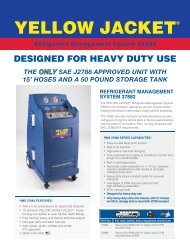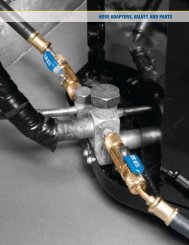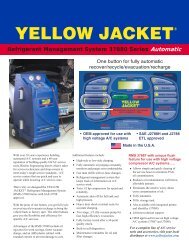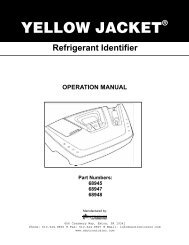VACUUM PUMP SYSTEMS - Yellow Jacket
VACUUM PUMP SYSTEMS - Yellow Jacket
VACUUM PUMP SYSTEMS - Yellow Jacket
Create successful ePaper yourself
Turn your PDF publications into a flip-book with our unique Google optimized e-Paper software.
EDITION 62 CATALOG<br />
The BULLET<br />
RECOVERY<br />
pulls down to 25 microns or better, protecting from contaminants and non-condensable<br />
gasses in the HVAC system, which can damage components, reduce effi ciency and cause system failure.<br />
• Wide mouth oil reservoir port for easier, cleaner<br />
filling. Doubles as pump exhaust; threaded to attach<br />
garden hose for exhausting to remote location<br />
• Large oil sight glass for easy monitoring of oil level<br />
• Large brass oil drain for easy access to fast<br />
oil changes<br />
• Internal intake check valve to help prevent oil<br />
backup into the system during a power failure<br />
Export EU/UK 93613 AU/NZ 93623 EU/UK 93615 AU/NZ 93625 EU/UK 93610 AU/NZ 93620<br />
Detachable IEC Cord type EU/UK AU/NZ EU/UK AU/NZ EU/UK AU/NZ<br />
Free air displacement 85/70 L/M 142/120 L/M 200/165 L/M<br />
Motor 1/2 hp - 1725 rpm/1425 rpm 1/2 hp - 1725/1425 rpm 1/2 hp - 1725/1425 rpm<br />
Voltage (dual phase) 115/230V / 50-60 Hz 115/230V / 50-60 Hz 115/230V / 50-60 Hz<br />
Dimensions 17" L x 6.25" W x 8.25" H 17" L x 6.25" W x 8.25" H 17" L x 6.25" W x 8.25" H<br />
(43.2 cm x 15.9 cm x 21 cm) (43.2 cm x 15.9 cm x 21 cm) (43.2 cm x 15.9 cm x 21 cm)<br />
Net weight 32.1 lbs (14.6 kg) 33 lbs (15 kg) 34.5 lbs (15.7 kg)<br />
HOW TO MEASURE AN “ADEQUATE” <strong>VACUUM</strong><br />
Many contractors pull the refrigerant out and think the work<br />
is done. In reality, when you get to 29 inches of vacuum (the<br />
green zone on your gauge), you are only half fi nished. Once the<br />
recovery machine has done its work, it’s time to fi nish off the job<br />
with a vacuum pump.<br />
Standard Lo-Side Gauge<br />
Shows vacuum in inches. A ±1% gauge would be accurate to ±7600 microns<br />
when calibrated at a full vacuum (which is generally not the case with this type<br />
of gauge).<br />
29<br />
30<br />
23,400 microns<br />
29.80 in.<br />
1,000 microns<br />
ASHRAE<br />
29.90 in.<br />
500 microns<br />
29.91 in.<br />
400 microns<br />
Equipment Manufacturers<br />
29.92 in.<br />
50-150 microns<br />
Only an electronic vacuum gauge can precisely measure the<br />
level at which non-condensable gas is removed from system.<br />
• Intake filter screen keeps damaging particles from<br />
entering the pump<br />
• Heavy-duty rotors and bearings<br />
• Heavy-duty steel handle for well-balanced carrying<br />
• Tethered port caps stay with the pump<br />
• Stable base; wide-stance metal with rubber overlay<br />
• Made in the USA<br />
Domestic Model 93603 Model 93605 Model 93600<br />
Free air displacement 3.0 cfm 5.0 cfm 7.0 cfm<br />
Number of stages 2-stage rotary vane 2-stage rotary vane 2-stage rotary vane<br />
Field blankoff 25 microns 25 microns 25 microns<br />
Intake 1/4" x 3/8" x 3/8" 1/4" x 3/8" x 3/8" 1/4" x 3/8" x 3/8"<br />
Motor 1/2 hp - 1725 rpm 1/2 hp - 1725 rpm 1/2 hp - 1725 rpm<br />
Thermal overload protection Yes Yes Yes<br />
Voltage (single phase) 115V/60 Hz 115V/60 Hz 115V/60 Hz<br />
Power cord 6' - motor mounted switch - U.S. plug 6' - motor mounted switch - U.S. plug 6' - motor mounted switch - U.S. plug<br />
Oil capacity 33.5 oz. (0.991 L) 30 oz. (0.9 L) 28 oz. (0.828 L)<br />
Dimensions 16.25" L x 6.25" W x 8.25" H 16.25" L x 6.25" W x 8.25" H 16.25" L x 6.25" W x 8.25" H<br />
(41.3 cm x 15.9 cm x 21 cm) (41.3 cm x 15.9 cm x 21 cm) (41.3 cm x 15.9 cm x 21 cm)<br />
Net weight 29.1 lbs. (13.2 kg) 30.0 lbs. (13.6 kg) 31.6 lbs. (14.3 kg)<br />
Why a Vacuum Pump?<br />
ASHRAE recommends evacuation to below 1000 microns for<br />
moisture removal and below 500 microns after replacing a<br />
compressor. Some equipment manufacturers call for evacuation<br />
to 400 microns to ensure that harmful water vapor is removed<br />
from the system.<br />
When you have water vapor in your system, the risk of icing up<br />
capillary tubing and expansion valves becomes much higher.<br />
A high quality vacuum pump will be able to take you down to<br />
200-500 microns. With the system almost completely free from<br />
water vapor, you are ready to put the refrigerant back in the<br />
system. A thorough approach to evacuation ensures longer<br />
equipment life and reduced risk of problems.<br />
Use a Vacuum Gauge to Read Vacuum Down to 25 Microns<br />
1000 microns equal only 0.039 inches of mercury, a<br />
measurement that cannot be made with a mechanical gauge,<br />
or determined by evacuation time or the sound of the pump.<br />
A popular tool that can measure vacuum at evacuation levels<br />
below 1000 microns is an electronic vacuum gauge.<br />
The best place to measure vacuum is at the system, not at the<br />
pump. With a combination vacuum/charging valve, you can<br />
attach the electronic vacuum gauge directly to the system and<br />
isolate it from the pump, hoses and manifold for a true indication<br />
of the vacuum in the system. With a digital vacuum gauge, you<br />
can see the last evidence of moisture being removed and witness<br />
that the system has been dried out.<br />
RECOVERY<br />
MACHINES<br />
<strong>VACUUM</strong> SUPEREVAC <strong>PUMP</strong><br />
<strong>SYSTEMS</strong><br />
<strong>VACUUM</strong> AND<br />
CHARGING HOSES<br />
HOSE ADAPTERS,<br />
VALVES AND PARTS<br />
CHARGING<br />
<strong>SYSTEMS</strong><br />
GAUGES<br />
ELECTRONIC<br />
INSTRUMENTS<br />
HEATING<br />
INSTRUMENTS<br />
LEAK MONITORS<br />
AND DETECTORS<br />
SYSTEM TOOLS<br />
11



